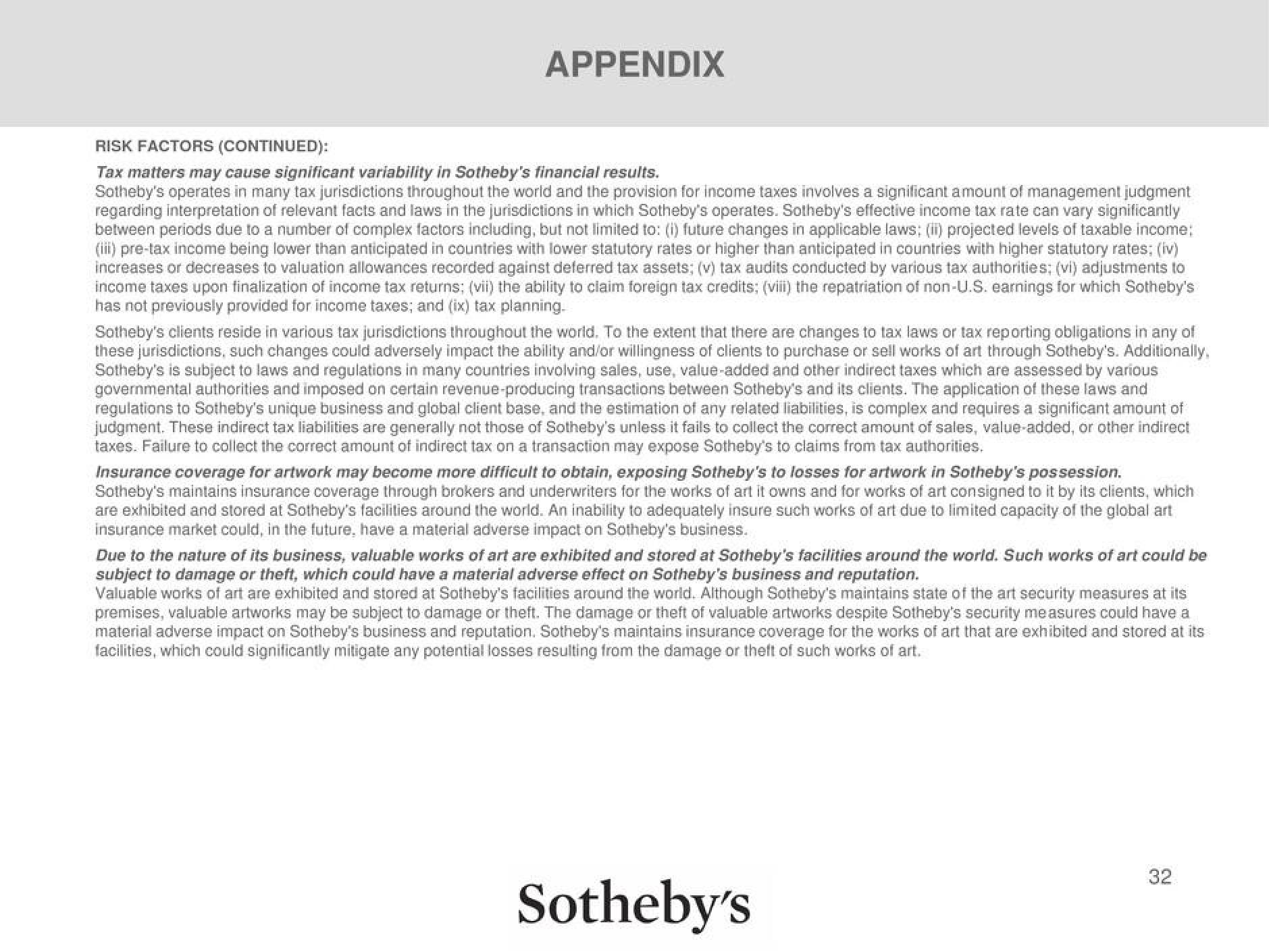Sotheby's Investor Briefing
APPENDIX
RISK FACTORS (CONTINUED):
Tax matters may cause significant variability in Sotheby's financial results.
Sotheby's operates in many tax jurisdictions throughout the world and the provision for income taxes involves a significant amount of management judgment
regarding interpretation of relevant facts and laws in the jurisdictions in which Sotheby's operates. Sotheby's effective income tax rate can vary significantly
between periods due to a number of complex factors including, but not limited to: (i) future changes in applicable laws; (ii) projected levels of taxable income;
(iii) pre-tax income being lower than anticipated in countries with lower statutory rates or higher than anticipated in countries with higher statutory rates; (iv)
increases or decreases to valuation allowances recorded against deferred tax assets; (v) tax audits conducted by various tax authorities; (vi) adjustments to
income taxes upon finalization of income tax returns; (vii) the ability to claim foreign tax credits; (vii) the repatriation of non-U.S. earnings for which Sotheby's
has not previously provided for income taxes; and (ix) tax planning.
Sotheby's clients reside in various tax jurisdictions throughout the world. To the extent that there are changes to tax laws or tax reporting obligations in any of
these jurisdictions, such changes could adversely impact the ability and/or willingness of clients to purchase or sell works of art through Sotheby's. Additionally,
Sotheby's is subject to laws and regulations in many countries involving sales, use, value-added and other indirect taxes which are assessed by various
governmental authorities and imposed on certain revenue-producing transactions between Sotheby's and its clients. The application of these laws and
regulations to Sotheby's unique business and global client base, and the estimation of any related liabilities, is complex and requires a significant amount of
judgment. These indirect tax liabilities are generally not those of Sotheby's unless it fails to collect the correct amount of sales, value-added, or other indirect
taxes. Failure to collect the correct amount of indirect tax on a transaction may expose Sotheby's to claims from tax authorities.
Insurance coverage for artwork may become more difficult to obtain, exposing Sotheby's to losses for artwork in Sotheby's possession.
Sotheby's maintains insurance coverage through brokers and underwriters for the works of art it owns and for works of art consigned to it by its clients, which
are exhibited and stored at Sotheby's facilities around the world. An inability to adequately insure such works of art due to limited capacity of the global art
insurance market could, in the future, have a material adverse impact on Sotheby's business.
Due to the nature of its business, valuable works of art are exhibited and stored at Sotheby's facilities around the world. Such works of art could be
subject to damage or theft, which could have a material adverse effect on Sotheby's business and reputation.
Valuable works of art are exhibited and stored at Sotheby's facilities around the world. Although Sotheby's maintains state of the art security measures at its
premises, valuable artworks may be subject to damage or theft. The damage or theft of valuable artworks despite Sotheby's security measures could have a
material adverse impact on Sotheby's business and reputation. Sotheby's maintains insurance coverage for the works of art that are exhibited and stored at its
facilities, which could significantly mitigate any potential losses resulting from the damage or theft of such works of art.
Sotheby's
32View entire presentation